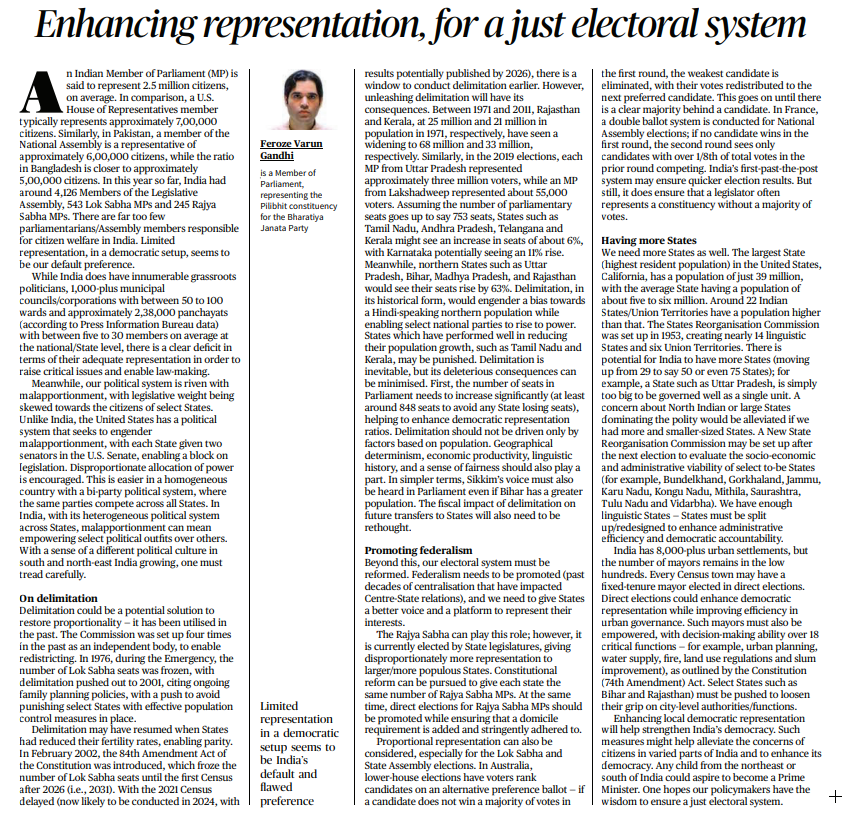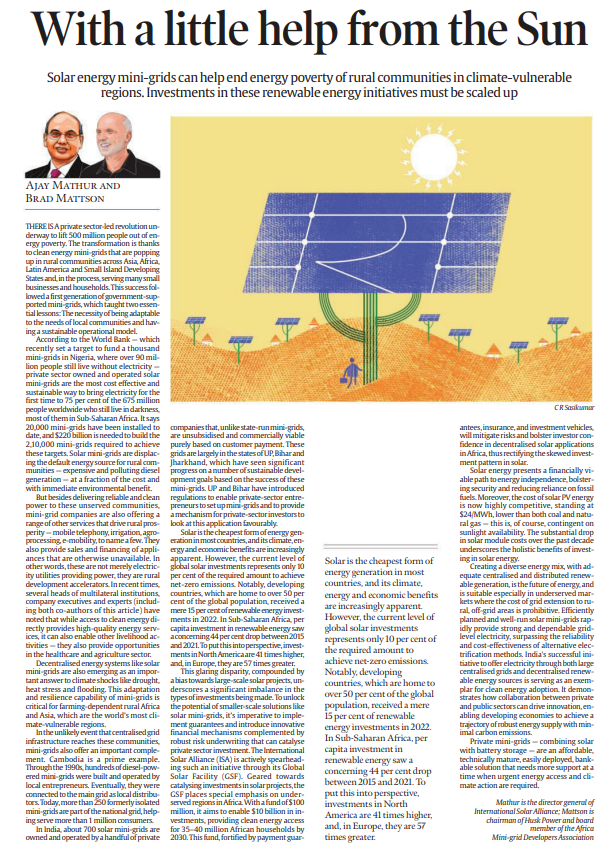Introduction
The editorial analysis discusses the representation of citizens in India’s political system, highlighting the significant disparity between the number of citizens each Member of Parliament (MP) represents in India compared to other countries like the United States, Pakistan, and Bangladesh. It emphasizes the limited representation and malapportionment issues in the Indian political landscape.
Inadequate Representation in India
- Citizen-to-MP Ratio:
– Indian MPs represent an average of 2.5 million citizens.
– U.S. House of Representatives members represent about 700,000 citizens.
– Similar ratios exist in Pakistan and Bangladesh.
- Limited Representation:
– Despite numerous grassroots politicians and local bodies, there is a deficit in adequate representation to address critical issues and enable effective law-making.
Malapportionment in India
- Legislative Weight Disparity:
– Malapportionment is evident, with legislative weight skewed towards citizens of select states.
– Unlike the U.S., India’s diverse political system can lead to empowering specific political outfits over others.
- Caution Needed:
– Growing political differences in south and northeast India necessitate careful consideration of malapportionment consequences.
Delimitation as a Potential Solution
- Historical Perspective:
– Delimitation has been utilized in the past to restore proportionality.
– Instances of seat freezing and delays due to factors like family planning policies are noted.
- Consequences of Delimitation:
– Potential consequences include bias towards northern populations and empowerment of select parties.
– States with population control measures might be adversely affected.
- Mitigating Deleterious Effects:
– Increase the number of parliamentary seats significantly to avoid state seat losses.
– Consider factors beyond population, such as geographical determinism, economic productivity, linguistic history, and fairness.
Reforming the Electoral System
- Promoting Federalism:
– Advocate for federalism promotion to give states a better voice and platform.
– Suggest constitutional reforms for equitable representation in the Rajya Sabha.
- Proportional Representation:
– Consider proportional representation for Lok Sabha and State Assembly elections.
– Explore alternative voting systems from countries like Australia and France to ensure clearer majority support.
Increasing the Number of States
- States Reorganisation Commission:
– Propose setting up a new State Reorganisation Commission to assess socio-economic and administrative viability.
– Consider creating more states, moving from 29 to 50 or 75, to enhance governance efficiency and democratic accountability.
- Empowering Local Governance:
– Advocate for direct elections of mayors in Census towns to enhance democratic representation.
– Mayors should be empowered with decision-making abilities over critical functions to improve urban governance.
Conclusion
The editorial calls for a comprehensive approach to address the issues of inadequate representation, malapportionment, and governance efficiency in India’s political system. It suggests delimitation, electoral reforms, and an increased number of states as potential solutions to strengthen democratic representation and alleviate concerns across diverse regions in India.
Private Sector-Led Revolution: Solar Mini-Grids as Catalysts for Rural Development
Introduction:
- A private sector-driven transformation is underway to address energy poverty, employing clean energy mini-grids in rural areas across Asia, Africa, Latin America, and Small Island Developing States.
- This revolution is marked by adaptability to local needs and sustainable operational models learned from the first generation of government-supported mini-grids.
Cost-Effective and Sustainable Solutions:
- According to the World Bank, privately owned solar mini-grids are identified as the most cost-effective and sustainable means to bring electricity to 75% of the 675 million people worldwide without access.
- The success so far includes 20,000 installed mini-grids, with a projected need for $220 billion to build 210,000 more, particularly targeting Sub-Saharan Africa.
- Solar mini-grids are effectively replacing expensive and polluting diesel generators.
Beyond Electricity:
- Mini-grid companies not only deliver clean power but also drive rural prosperity by offering additional services such as mobile telephony, irrigation, agro-processing, and e-mobility.
- They also play a role in providing financing for appliances, contributing to overall rural development.
Adaptation to Climate Shocks:
- Decentralized energy systems, particularly solar mini-grids, are emerging as vital responses to climate shocks in farming-dependent regions like rural Africa and Asia.
- Their adaptability and resilience prove critical in mitigating the impact of droughts, heat stress, and flooding.
Complementing Centralized Grids:
- In cases where central grid infrastructure reaches communities, mini-grids offer a complementary solution.
- Cambodia’s example illustrates how formerly isolated mini-grids became integrated into the national grid, benefiting over a million consumers.
Case Studies – India and Cambodia:
- In India, private companies operate 700 solar mini-grids, showing significant progress in sustainable development goals.
- Meanwhile, Cambodia’s experience highlights the successful integration of diesel-powered mini-grids into the national grid.
Global Disparities and the Role of Solar Energy:
- Global investment in solar energy remains disproportionately low, with developing countries receiving only 15% of renewable energy investments in 2022.
- The International Solar Alliance’s Global Solar Facility aims to rectify this imbalance, providing $100 million to catalyze $10 billion in solar projects, particularly in underserved African regions.
Financial Viability of Solar Energy:
- Solar energy is presented as a financially viable path to energy independence, with a cost of $24/MWh, lower than coal and natural gas.
- The drop in solar module costs over the past decade underscores the overall benefits of investing in solar energy.
Diverse Energy Mix for the Future:
- Advocating for a diverse energy mix, the article emphasizes the significance of both centralized and distributed renewable generation.
- Solar mini-grids, especially in underserved markets, demonstrate reliability and cost-effectiveness, surpassing alternative electrification methods.
India’s Exemplary Model:
- India’s success in offering electricity through both centralized grids and decentralized renewable sources serves as an exemplar for clean energy adoption.
- The collaboration between private and public sectors drives innovation, achieving robust energy supply with minimal carbon emissions.
Conclusion
The editorial concludes by advocating for more support for private mini-grids, combining solar with battery storage, as an affordable, mature, easily deployed, and bankable solution. This comes at a crucial time when urgent action is needed for both energy access and climate mitigation.



